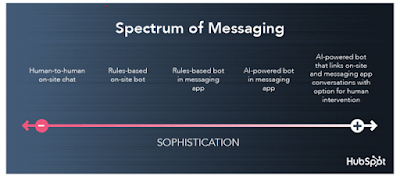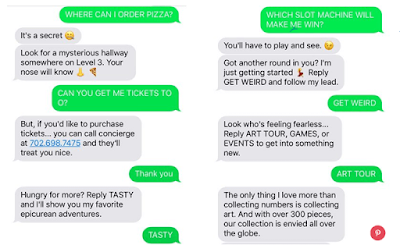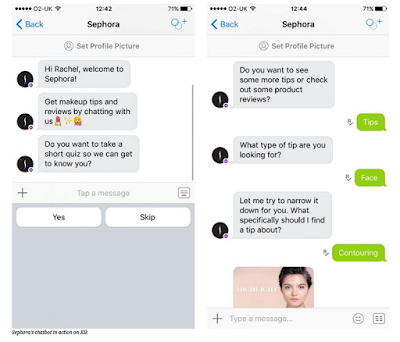When I was writing the first edition of
Internet Marketing back in the internet bubble and burst days of 2000 – 2002, I was especially pleased to have added a customer service chapter to the standard marketing fare. That effort was full of discovery including “agent technology” at a firm called Artificial Life, which no longer seems to exist at least in the same format. The featured bot was Lucy McBot, who was able to speak to the user in several different languages. As I remember there were several bot personas and good demos on the website. Using them in the classroom was fun and one of the book’s adopters pointed out to me that Lucy was programmed with snarky answers if a caller asked for a date. And that is exactly my point. They used programed responses and since natural language understanding was well less developed, these early bots were limited in their ability to communicate.
By the third edition the virtual agents had dropped out in favor of other technology advancements like mobile apps and social media, although there is one brief mention of virtual assistants. That perspective continued into the current edition with focus on customer experience in multi-channel environments and the impact of social media on experience. There just didn’t seem to be exiting developments in the use chatbots in customer care.
 |
| HubSpot Messaging Timeline |
Fast forward about two years from the time that chapter was being written and witness the explosion of the intelligent (AI-driven) chatbot. It is one aspect of the explosion in AI that is all around us and offering many opportunities to marketers. HubSpot traces the evolution of bots from those early days to the AI-driven bots of today.
How Marketers Are Using Chatbots
Marketers are continuing to improve customer service bots, especially by adding AI. One article indicates that there is an opportunity for US businesses to automate 30% more of their customer contacts and save over $23 billion in customer service costs. Bots, though, are now being used in many more marketing applications. Some examples are:
• The Cosmopolitan Hotel in Las Vegas introduced
a bot named Rose in January 2017. For visitors Rose fields texts to room service as well as texts that would otherwise be questions for a human concierge (a human is standing by in case Rose can’t answer the question). She is fond of snappy answers and emojis, as you can see from the conversation below.
 |
| A Conversation with Rose at the Las Vegas Cosmopolitan Hotel |
Rose also helps potential guests book their stay at the Cosmopolitan. The agency that designed Rose says that guests who booked on the Cosmopolitan site through Rose spent 39% more than guest who did not engage with the bot.
•
1-800-Flowers was already using Facebook Messenger. When Facebook added chatbots to Messenger in 2016 they were quick to create one. Later they added an IBM Watson-powered bot called Gwyn (Gifts When You Need) to their site. 1-800-Flowers says that over 70% of chatbot orders have come from new customers and those new customers are younger than its existing base
•
Sephora introduced its Kik messaging app with a Story on Snapchat to attract the teen segment of its audience. The app features a quiz that helps the bot understand the user’s makeup needs.
 |
| Sephora Chatbot |
Sephora already had two Facebook Messenger bots, a Reservation Assistant for booking facials and Virtual Assist to help in selecting makeup colors.
• In
2016 the NBA launched a bot on Facebook Messenger so fans could chat about the NBA finals. The app asks the user to select the team, then whether she wants playoffs or game highlights. A highlights offering is shown below. Not to be outdone, the
Golden State Warriors created a bot for the 2017 playoffs. The chatbots follow on the heels of the NBA mobile app discussed in Chapter 12.
Notice that the chatbots are being used either for direct sales or for customer engagement. And especially notice that many of them are on messaging platforms, not the brand’s website. Why is that?
Bot Platforms
Why are so many chatbot apps being built on messaging platforms? HubSpot has a
powerful answer:
bots solve the thing we loathed about apps in the first place. You don't have to download something you'll never use again. It's been said most people stick to five apps. Those holy grail spots? They're increasingly being claimed by messaging apps. Today, messaging apps have over 5 billion monthly active users, and for the first time, people are using them more than social networks.
The statistics vary a bit, but there is agreement on which messaging platforms are the top three. These numbers are taken from Statista 2071 reports for consistency. Monthly active user for each platform are:
• WhatsApp 1.3 b
• Facebook Messenger 1.2 b
• WeChat 963m
Other trending messaging platforms include Kik, LINE, Telegram and Kakaotalk.
The marketers in the examples above were already using messaging apps. Why take on the challenge of trying to create an audience for a downloaded app, especially when most are not used for long?
There many services in addition to the guidance provided on the platforms that will assist the technically-deficient marketer in building apps. Many offer free initial use. Here are 3 lists and there are many more.
1 2 3
How Chatbots Can Boost Marketing Impact
As the examples show, intelligent chatbots have much to offer marketers. They can make it easy and fun to communicate with a brand, thus
building engagement. In addition to making sales and enabling payments, they can help qualify leads. In addition:
• They can send notifications.
• They can collect feedback and generate insights.
• They can offer
personalized experiences.
• They can give impetus to a
content marketing strategy.
AI-driven chatbots have burst upon the scene and established themselves as an important factor in marketing with great rapidity. Marketers would be well advised to look for opportunities to increase their effectiveness with chatbots. As they do, they must remember that, in the end, customer experience is all important!
See infographic with additional data
Related Updates
Chatbot
metrics
2018 chatbot trends
Status of chatbots with link to full Accenture report
This a
robot, not a chatbot but it's worth sharing and comes with a short video and links to others
Good report on
AI in the enterprise







